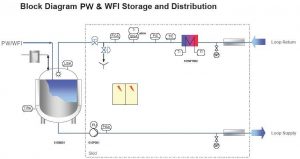Storage, Distribution & Looping

PW and WFI Storage and Distribution:
Once water for pharmaceutical use has been obtained, it must be stored and distributed to the points of use; there is no point in producing quality water unless it is correctly stored and distributed. This stage is of vital importance to minimize possible contamination of the water and the proliferation of micro-organisms. Systems must be sealed with continuous recirculation and must have a sanitization system.
The individual components of the storage and distribution system are described in the following.
Storage and Distribution skids:
The equipment indicated for the parts of the system that come into contact with the water should be of 316L stainless steel, ideally with internal surfaces polished to below 0.8 µm (ASME BPE). Other materials may be used such as polypropylene for example, however these systems have limitations and are rarely used. All elements in contact with the water must be of the sanitary type, and connections must be made by orbital welding or be tri-clamp connections.
The main items of equipment in a storage and distribution system are:
- Storage Tank
- Impeller Pump
- Heat Exchanger
- Ultraviolet Radiation Equipment (In purified water only)
- Main instrumentation:
- Level Transmitter
- Conductivity sensor
- Flow Meter
- Temperature Probe
- Pressure Transmitters
- Control Panel
Distribution loops:
The water distribution loop must be made from sanitary materials of the same characteristics as those of the storage and distribution skid. The main characteristic is that they must be 100% drainable so they will be designed with gradients towards the points of use so that in the event of a shutdown of the installation no water will be retained in the loop. As for fluid mechanics, the water must circulate in the pipe in turbulent flow (speeds over 1 m/s and Reynolds number over 10,000 are advisable) in order to minimize risks of contamination which would occur if it were to circulate in laminar flow, a positive pressure must also be guaranteed in the return to the tank (1 bar). For this, various instruments will be used such as a variable speed drive for the pump, pressure probe and flow meter.
The loops must be correctly insulated in order to minimize heat loss, thus achieving considerable energy saving, and in clean rooms this must be of stainless steel.
The fixing of the installation must be made using hex type sanitary pipe hangers covered with polymer material (according to the temperature) to minimize the risk of external corrosion of the pipe.
The main elements of the distribution loop are:
- Pipe
- Fittings
- Point of use valves (Diaphragm Type)

Pure steam distribution systems:
Pure steam distribution systems are designed so that the least quantity of condensates enters the equipment to be sterilized. Components in contact with clean steam are comprised of 316L stainless steel, ideally with internal surfaces polished to below 0.8 µm (ASME BPE). All elements in contact with the steam are of the sanitary type, and connections are made by orbital welding or by tri-clamp connections.
This distribution is well insulated to minimize heat loss and the production of condensate, as well as achieving energy savings.
Each clean steam network is bespoke to the client, hand built at Manufacturer’s facility, but the main components are:
- Piping
- Fittings (elbows, tees etc.)
- Point of use valves
- Steam traps
